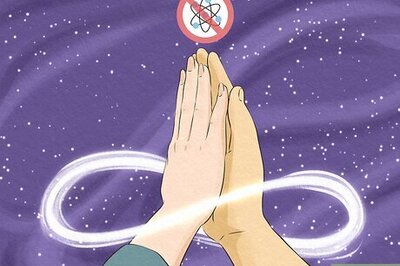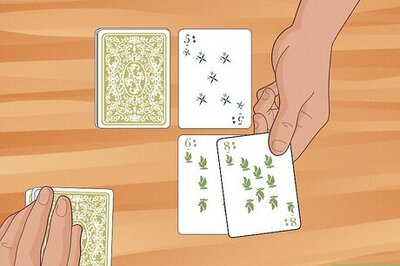
views
New Delhi: Actor-turned politician Shatrughan Sinha on Friday officially joined the Congress, ending days of suspense over his association with the grand old party. Sinha launched a scathing attack on the BJP after his exit, saying there was no concept of collective decision in the saffron party and he was disowned by the party because of his association with BJP veteran LK Advani.
Earlier, actor Jaya Prada joined the BJP and is likely to challenge Samajwadi Party strongman Azam Khan, who once ensured her debut victory from the very same seat of Rampur.
With more and more film stars taking a leap and transiting from cinema to politics, Sinha’s foray into politics, however, isn’t new.
Earlier, Sinha was an MP from the Patna Sahib constituency in Bihar and fought from a BJP ticket. He was also a Union Cabinet Minister of Health and Family Welfare and Shipping in the Atal Bihari Vajpayee government.
Likewise, the Trinamool Congress (TMC) has already announced five top Bengali actors, including three sitting MPs, who will contest the upcoming Lok Sabha polls.
However, film stars making a mark into Indian politics is not a new phenomenon. Striding on the silver screen like a colossus and forging a larger-than-life onscreen image of themselves, many actors have later on turned to politics and made a remarkable impact.
So much so that the lower House of Parliament has always seen entrants from acting backgrounds since the very first Lok Sabha elections in 1952, actors Harindranath Chattopadhyay and Paidi Lakshmayya being the first two of them.
Since then, 58 actors have entered the poll fray for a seat in the Lok Sabha. Of them, 48 stars have become lawmakers at least once and this doesn’t include the nominations of several actors to the Rajya Sabha.
This is only an analysis of actors, not celebrities, who contested from various Lok Sabha seats across India.
If we take a look at the 2014 general election, there were 22 actors who contested the elections from various seats.
It was the maximum number of actor-candidates in any election in the history of India. Once the results were out, 12 of them won, while 10 others lost.
The names of winners include Dev, Hema Malini, Kirron Kher, Moon Moon Sen, Paresh Rawal, Chirag Paswan, Innocent, Manoj Tiwari, Murli Mohan Maganti, Sandhya Roy, Satabdi Roy and Babul Supriyo.
Actors Rakhi Sawant, Mahesh Manjrekar, Aprajita Mohanty, Javed Jaffrey, Nagma, Navneet Kaur Rana, Ramya, Ravi Kishan, Bappi Lahiri and Gul Panag could not make it to the lower House in 2014.
Though various parties have tried to cash in on the popularity of these film personalities over the period of time, it is the BJP which has topped the list by giving candidature to a maximum number of actors for Lok Sabha seats.
Since the formation of the party in 1980, the BJP has given Lok Sabha tickets to 18 film stars.
The Aam Aadmi Party (AAP), Dravid Munnetra Kazagham (DMK), Janata Dal (JD), Samajwadi Party (SP), Telangana Rashtra Samiti (TRS), Lok Janshaki Party (LJP) and Maharashtra Navnirman Sena (MNS) are the other parties who have tried their fate by betting on the actors.
While all the Trinamool Congress candidates Dev, Satabdi Roy, Sandhya Roy and Moon Moon Sen won by a good margin in Bengal, the AAP had fielded Javed Jaffrey and Gul Panag, both of whom failed to win. Panag was defeated by BJP’s actor-candidate Kirron Kher.
A News18.com analysis also shows that of the total 58 Lok Sabha candidates, 39 have made it to Parliament, while 19 faced defeat.
However, some of them have also held the seat for more than one term. These include Sunil Dutt, Vinod Khanna, Shatrughan Sinha, Raj Babbar, Jayaprada, Mahesh Kumar Kanodiya, Satabdi Roy, Siddhanta Mahapatra, Vyjayantimala, and Ambareesh.
Dutt, a veteran actor, had served as many as five terms in the lower House. He was also a minister of youth affairs and sports during the Manmohan Singh regime.
A total of six MPs on this list have also served as ministers in various governments. These include Babul Supriyo, Vinod Khanna, Sunil Dutt, Napoleon, Shatrughan Sinha, Ambareesh and Smriti Irani.
While Ambareesh held the office as information and broadcast minister, Vinod Khanna served as culture and tourism minister and Babul Supriyo was an urban development minister.
Another south star Napoleon was social justice and empowerment minister in the UPA government, while Shatrughan Sinha and Smriti Irani both held two ministries at different times.
Sinha was a health and family welfare as well as shipping minister in the Atal Bihari Vajpayee government, while Irani held the office as information and broadcast minister as well as human resource development minister in the outgoing government.
The analysis also shows that Andhra Pradesh has witnessed the highest number (nine) of actor-candidates in the Lok Sabha election until now.
Andhra was the first state to send an actor-candidate (Harindranath Chattopadhyay) to the first Lok Sabha (Vijaywada constituency) in 1952.
Uttar Pradesh is second on the list with seven actor-candidates with Bollywood megastar Amitabh Bachchan being one of them. He contested from the Allahabad constituency on a Congress ticket and won by a margin of around 42% in 1984. Later, he stayed away from active politics.
Jayaprada, Hema Malini, Raj Babbar are the others who entered Parliament by contesting from UP. They contested and won from Rampur, Mathura, and Agra, respectively.
Out of the 58 candidates, 35 (60.3%) are from the regional film industries, while the remaining 23 (39.6%) are popular Bollywood actors.
The popularity of these stars usually gets converted into votes for parties and helps them seize the seat. Apart from that, it is also evident that those who have won have achieved the victory with quite a good margin.
The highest being that of Bachchan (42.2%) and the lowest being 4.3 per cent by Govinda.
While the range has varied a lot, the average of the winning margin of the actors turned out to be 13.4% in Lok Sabha elections.














Comments
0 comment